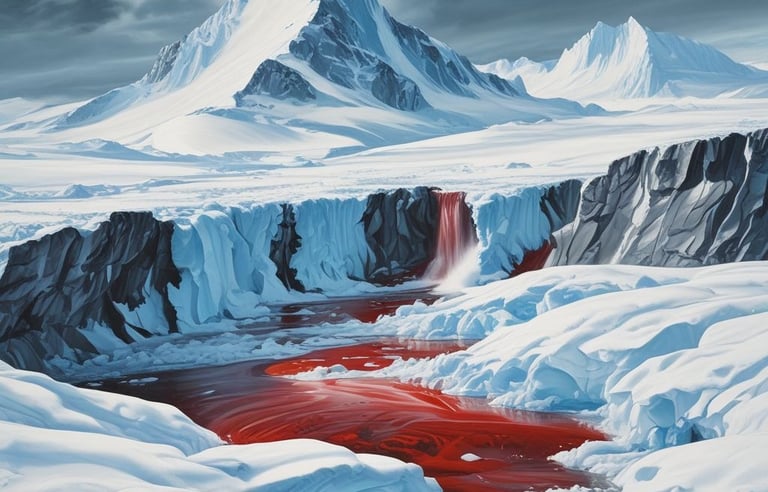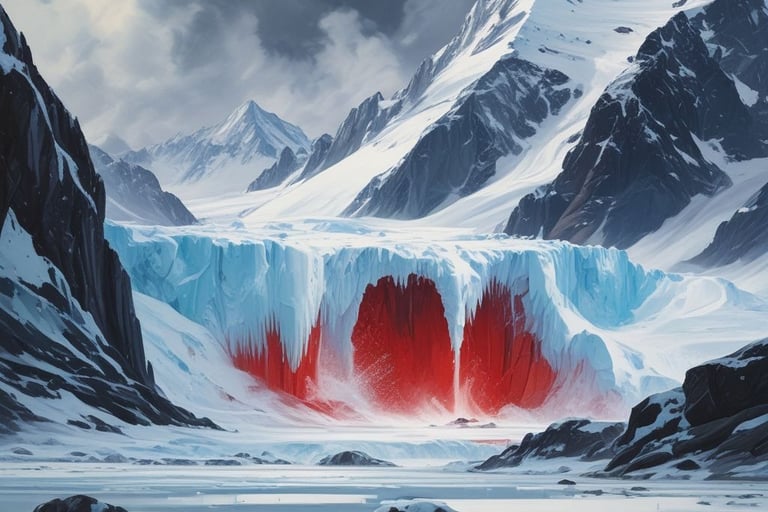Blood Falls: The Scarlet Secret of Taylor Glacier
Step into the frozen frontier of Antarctica, where a hidden crimson cascade defies the icy silence to reveal a story of ancient secrets. Join us as we unravel the captivating mystery of Blood Falls and explore the science behind this mesmerizing marvel.
MINDMUSE


Deep within the icy wilderness of Antarctica, where silence and frost create a surreal landscape, an extraordinary phenomenon disrupts the pristine expanse of Taylor Glacier—Blood Falls. Found at the southern end of Taylor Glacier in the McMurdo Dry Valleys, this crimson cascade got its evocative name from its striking resemblance to flowing blood. More than just a visual marvel, Blood Falls tells a story of ancient waters, elemental chemistry, and resilient life that has persisted in isolation for millions of years. Its secrets not only illuminate a hidden chapter of Earth’s history but also offer tantalizing clues about the potential for life beyond our planet.
In 1911, during the British Antarctic Expedition led by Robert Falcon Scott, Australian geologist Thomas Griffith Taylor first documented the eerie spectacle of red water seeping from the glacier. His groundbreaking observations not only led to the discovery of Blood Falls but also left such an impact on Antarctic science that the glacier was later named Taylor Glacier in his honour.
Early observers, struck by the vivid, blood-like hue, initially attributed the red colour to red algae. However, further investigations revealed that the phenomenon was rooted in unique geochemical processes occurring beneath the ice.
The Science Behind the Red Flow
The haunting red colour of Blood Falls originates from the oxidation of iron-rich water. Beneath the glacier lies an ancient subglacial lake, a relic from a time when Antarctica’s ice sheets were just beginning to form. This isolated reservoir, enriched with iron and devoid of oxygen, remains liquid thanks to its extreme salinity—a trait that keeps it unfrozen even in temperatures below -10°C (14°F). When this iron-saturated water escapes from its icy confines and encounters atmospheric oxygen, it undergoes a process akin to rusting, producing the dramatic, blood-like flow that has both puzzled and inspired scientists.
Key Scientific Processes:
Iron Oxidation: The iron in the briny water reacts with oxygen to form iron oxide (rust), which imparts the characteristic red colour.
Hypersalinity: With a salt concentration roughly three times that of seawater, the water’s freezing point is significantly depressed.
Cryoconcentration: As the glacier compacts, water is forced through narrow channels, increasing its salt content further and inhibiting ice formation.
Geothermal Influence: Subtle heat from Earth's interior helps maintain the liquid state of the subglacial water despite the extreme cold.
At the source of Blood Falls lies a hidden subglacial lake that has been sealed beneath Antarctica’s ice for an estimated 1.5 to 2 million years. Once part of an ancient ocean, this reservoir became isolated as glaciers advanced, transforming it into a self-contained ecosystem. Deprived of sunlight and oxygen, yet enriched with iron and sulphur, the lake presents conditions that are not only unique on Earth but also analogous to environments we might expect to find on other worlds.
One of the most astonishing aspects of Blood Falls is the discovery of extremophiles—microorganisms that flourish in environments where life would seem impossible. Unlike most life on Earth, these microbes do not depend on oxygen or sunlight. Instead, they survive through chemosynthesis, deriving energy from the iron and sulphur compounds abundant in the briny water.
The existence of such life in a seemingly inhospitable setting has far-reaching implications for space exploration and the search for extraterrestrial organisms. It bolsters the idea that similar microbial ecosystems could exist in the hidden oceans beneath the icy crusts of Jupiter’s moon Europa or Saturn’s moon Enceladus. In this way, Blood Falls serves as a natural laboratory, offering valuable insights into how life might endure under extreme conditions elsewhere in the cosmos.
Blood Falls: A Scarlet Symphony Frozen in Time.


Nature’s paradox—where salt conquers cold, preserving an unfrozen legacy beneath the ice.
Modern Research and Cutting-Edge Discoveries
Recent advances in radar imaging and ice-penetrating technology have allowed researchers to peer beneath Antarctica’s icy veil, unveiling new details about Blood Falls and its underlying ecosystem. Supported by agencies such as the National Science Foundation (NSF) and NASA, modern research continues to expand our understanding of this enigmatic phenomenon.
Recent Breakthroughs:
Persistent Liquidity: Studies confirm that the subglacial brine remains semi-liquid, its extreme salinity effectively counteracting the harsh cold.
Ancient Lineages: Genetic analyses reveal that the microbes inhabiting Blood Falls represent ancient lineages, isolated for millions of years.
Wider Implications: Discoveries hint that similar subglacial brine reservoirs may be more common than previously thought, both on Earth and potentially on other planets.
Blood Falls is much more than an isolated Antarctic oddity—it is a living laboratory that connects us to Earth's distant past and beckons us toward future discoveries. Its iron-rich waters, ancient microbial life, and the hidden subglacial lake all offer a glimpse into the resilience of life under extreme conditions. As we continue to push the boundaries of exploration, both on Earth and across the cosmos, Blood Falls stands as a powerful reminder: where there is water, even in the most unlikely places, there is the potential for life.
This crimson enigma not only deepens our understanding of geological and biological processes but also fuels our curiosity about what other secrets lie hidden beneath the ice, waiting to be discovered.
